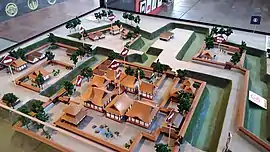Tsutsujigasaki Castle
Tsutsujigasaki Castle (躑躅ヶ崎館, Tsutsujigasaki yakata) was the fortified residence of the final three generations of the Takeda clan, located in what is now the city of Kōfu, Yamanashi Prefecture, Japan. It is not a castle in the proper sense of the word, and is not referred to as a "castle" in Japanese, as it was famously the policy of the Takeda clan to "make men your castle, men your walls, men your moats". [1][2] Nevertheless, it is listed as one of Japan's Top 100 Castles. The site has been protected by the central government as a National Historic Site since 1938.[3] The site is open to the public and now contains the Takeda Shrine, a Shinto shrine dedicated to the deified spirits of the Takeda clan.
| Tsutsujigasaki Yakata | |
|---|---|
躑躅ヶ崎館 | |
| Kōfu, Yamanashi, Japan | |
 surviving moat of Tsutsujigasaki Yakata | |
 Tsutsujigasaki Yakata  Tsutsujigasaki Yakata | |
| Coordinates | 35°41′12″N 138°34′39″E |
| Type | flatland-style Japanese castle |
| Site information | |
| Controlled by | Takeda clan |
| Condition | Ruins |
| Site history | |
| Built | 1519 |
| Built by | Takeda Nobutora |
| In use | 1594 |


Background
The Takeda clan was a cadet branch of the Minamoto clan, and gradually gained control over Kai Province from the late Heian period from their bases at Hakusan Castle and Yato Castle. By the Sengoku period, they were the shugo of Kai Province, and Takeda Nobutora selected a location near the center of the province to build his fortified residence and jōkamachi in 1519. The location was on a gentle slope in the flatlands of the Kōfu Basin, and was considered indefensible by contemporary standards, which dictated that fortifications be built on mountains. Nobutora also built a mountain fortification (Yōgaiyama Castle) nearby as a supporting castle and final redoubt.
Description
Tsutsujigasaki consisted of two main enclosures surrounded by water moats. The central enclosure was 200 meters square and contained the private residence of the Takeda ruler. The western enclosure is 100 x 200 meters, and was a public area for the administration of the domain, with "umadashi"-style two-story fortified gates to the north and south. Flanking both enclosures and outside the main gates, and also surrounded by water moats, were two kuruwa secondary enclosures, the Miso-guruwa and Baio-guruwa. The only remains today are some of the surviving water-filled moats and some minor stonework. The Takeda Shrine, built in 1919 is in the centre of the site. To the right of the shrine is a museum, guarded by a stone Hello Kitty.[4] [5]
History
Tsutsujigasaki continued to serve as the principal residence of Takeda Shingen after he deposed his father in 1540. However, his son Takeda Katsuyori built Shinpu Castle, a new and larger castle at Nirasaki and transferred his residence there in 1581. The Takada clan was extinguished by the coalition forces of Oda Nobunaga and Tokugawa Ieyasu February 1582. Afterwards, Nobunaga's general Kawajiri Hidetaka ruled Kai Province from Tsutsujigasaki until Nobunaga's assassination. Kai Province then came under the direct control of the Tokugawa clan and with the completion of nearby Kōfu Castle in 1594, the site was abandoned.
References
- "Takedashi yakata" J Castle Explorer http://www.japanese-castle-explorer.com/castle_profile.html?name=Takedashiyakata
- "Tsutsujigasaki Palace" J Castle http://www.jcastle.info/castle/profile/28-Tsutsujigasaki-Palace
- "武田氏館跡". Cultural Heritage Online (in Japanese). Agency for Cultural Affairs. Retrieved 25 September 2018.
- "Takedashi yakata" J Castle Explorer http://www.japanese-castle-explorer.com/castle_profile.html?name=Takedashiyakata
- "Tsutsujigasaki Palace" J Castle http://www.jcastle.info/castle/profile/28-Tsutsujigasaki-Palace
- Motoo, Hinago (1986). Japanese Castles. Tokyo: Kodansha. p. 200 pages. ISBN 0-87011-766-1.
